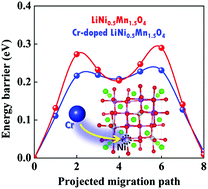Exploring the origin of electrochemical performance of Cr-doped LiNi0.5Mn1.5O4†
Abstract
Discorded LiNi0.5Mn1.5O4 has become a promising candidate for Li ion batteries due to its high specific energy. However, its poor structural stability restricts its practical application. After extensive exploration, Cr-doped disordered LiNi0.5Mn1.5O4 demonstrates enhanced structural stability and electrochemical performance. Thus far, its origin at the electronic structural level remains elusive, which is important to further performance improvement. First-principles calculations disclose that a Cr atom prefers to substitute Ni rather than a Mn atom. The transferred charge from Cr to Mn induces the reduction of Mn ions and lengthens the Li–O bond distance, which are mainly responsible for the lower Li ion diffusion energy barrier and Li vacancy formation energy. The heavy oxidation of O ions is a main factor to induce the structural degeneration. In this case, the reduced Mn ion delays the oxidation of the O ion, enhancing the structural stability. In addition, Cr doping increases the thermodynamic stability of intermediate phases during delithiation, decreasing the structural strain in the delithiation process. Ordered and disordered LiNi0.5Mn1.5O4 are also included for comparison. Our work provides an opportunity to fully understand Cr-doped LiNi0.5Mn1.5O4 at the atomic scale.

- This article is part of the themed collection: 2020 PCCP HOT Articles


 Please wait while we load your content...
Please wait while we load your content...